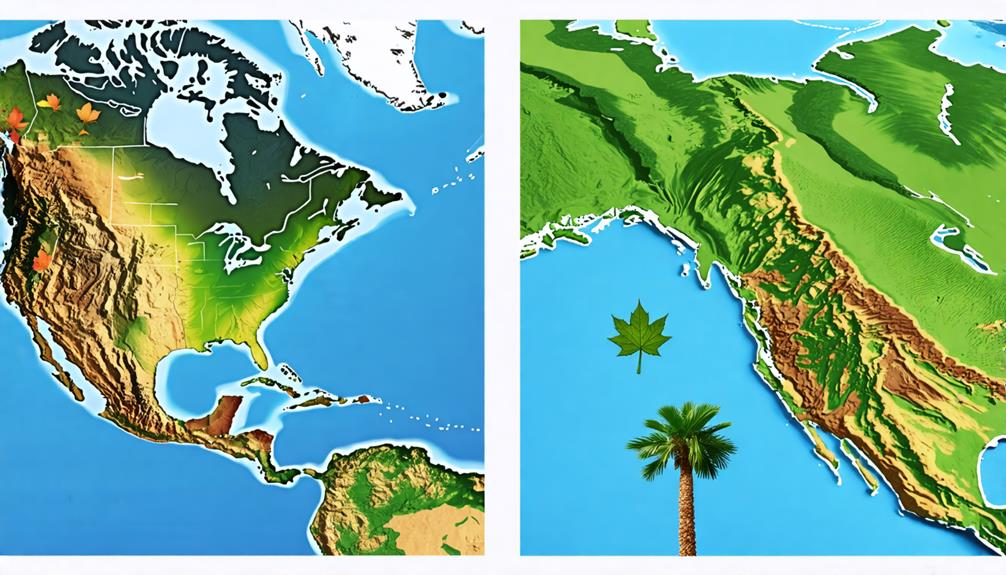You might be surprised to learn that parts of Canada stretch as far south as California's northern border. This geographical quirk challenges the common perception of Canada as a uniformly northern country. Point Pelee and Pelee Island in Ontario sit at latitudes comparable to northern California, offering unique climate conditions that support diverse agriculture, including wine production. These southern reaches of Canada showcase a different side of the country, one that's not often associated with its image. But there's more to this story than just latitude lines—the implications of this southward extension are far-reaching and often overlooked.
Key Takeaways
- Middle Island, Ontario, is Canada's southernmost point, reaching latitudes similar to California's northern border.
- Pelee Island and Point Pelee in Ontario extend further south than 27 U.S. states.
- Southern Ontario dips below the latitudes of Washington, Oregon, and parts of New York and Rhode Island.
- The misconception that all Canadian territory lies north of the U.S. border is incorrect.
Surprising Geographic Realities

You might be surprised to learn that parts of Canada dip farther south than you'd expect, challenging common assumptions about North American geography. The southernmost point of Canada isn't where you'd think—it's Middle Island, Ontario, followed closely by Pelee Island.
These islands, along with Point Pelee on the mainland, extend as far south as California's northern border. In fact, Point Pelee sits further south than 27 U.S. states.
The surprising geographic realities of southern Ontario reveal that significant portions of Canada stretch below the US/Canada border you might imagine. The southern tip of Ontario reaches latitudes lower than Washington, Oregon, and parts of New York and Rhode Island.
This geographic positioning shatters the misconception that all of Canada lies north of the United States, highlighting the complex nature of North American borders.
Climate and Agricultural Implications
While many associate Canada with a colder climate, its southern regions enjoy milder temperatures that greatly impact agricultural possibilities.
You'll find Pelee Island, Ontario, Canada's southernmost point, benefiting from Lake Erie's climate-moderating effect. This unique microclimate allows for diverse agricultural practices, including wine production typically associated with warmer climates. Surprisingly, parts of southwestern Ontario experience milder winters than some southern U.S. cities, extending growing seasons and promoting agricultural diversity.
The Niagara Peninsula also boasts microclimates conducive to grape cultivation, challenging traditional perceptions of Canada's agricultural potential.
Even Victoria, British Columbia, on the Canadian mainland, enjoys winter temperatures comparable to Raleigh, North Carolina.
These unexpected climate realities highlight Canada's diverse agricultural landscape, demonstrating that the country's growing capabilities extend far beyond what you might initially assume based on its northern reputation.
Border Anomalies and Misconceptions

Beyond surprising climate realities, Canada's southern reach extends further than most people realize, challenging common perceptions about the U.S.-Canada border.
You might be surprised to learn that Canada's southernmost point, Middle Island, Ontario, lies south of several U.S. states. Even more astonishing, Point Pelee on the Canadian mainland is south of 27 U.S. states, completely below 13 of them. These border anomalies stem from surveying errors and unique geographical features, resulting in Canadian territory extending far south of what's commonly believed.
Misconceptions about Canada being entirely north of the U.S. are widespread, but parts of Canada actually reach as far south as northern California. The 49th parallel border isn't as straightforward as you might think, with areas like Windsor, Ontario sitting south of Detroit, Michigan.
These facts illustrate the complex nature of the U.S.-Canada border.
Conclusion
You've discovered a surprising fact about Canada's geography. It's not all snow and ice!
Parts of the country reach as far south as northern California, challenging your perceptions. This southerly position brings unexpected climate benefits, allowing for diverse agriculture and even wine production.
Next time you're thinking about Canada, remember it's more than just the Great White North. There's a whole world of geographic surprises waiting for you to explore.

Leave a Reply